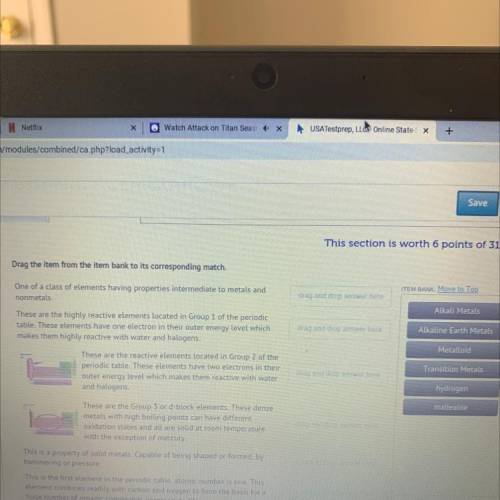
Chemistry, 09.12.2020 22:20 beeboppity
One of a class of elements having properties intermediate to metals and nonmetals.
These are the highly reactive elements located in Group 1 of the periodic table. These elements have one electron in their outer energy level which makes them highly reactive with water and halogens.
These are the reactive elements located in Group 2 of the periodic table. These elements have two electrons in their outer energy level which makes them reactive with water and halogens.
These are the Group 3 or d-block elements. These dense metals with high boiling points can have different oxidation states and all are solid at room temperature with the exception of mercury.
This is a property of solid metals. Capable of being shaped or formed, by hammering or pressure.
This is the first element in the periodic table, atomic number is one. This element combines readily with carbon and oxygen to form the basis for a huge number of organic compounds necessary to life.


Answers: 2


Other questions on the subject: Chemistry

Chemistry, 22.06.2019 05:50, carog24
Astudent made a graph plotting the progress of a reaction over time. the student forgot to label the y-axis of the graph. a graph is shown with two graph lines. one graph line starts at a higher position on the y axis and slopes downwards towards the right. the other graph line starts at a lower position on the y axis and slopes upwards towards the right. the two graph lines stop short of intersecting each other and continue as separate lines which gradually become straight and parallel to the x axis. a vertical line is shown at a point where the two graph lines finally became parallel to the x axis. this vertical line is labeled equilibrium. the title on the x axis is time and an arrow pointing towards the right is shown above time. the title on the y axis is left blank. what best explains the label that the student should use on the y-axis? amount, because as the amount of product decreases, the amount of reactant increases over time. reaction rate, because forward and backward reaction become equal at equilibrium. amount, because the amounts of reactants and products become constant after equilibrium is reached. reaction rate, as the rate of forward reaction increases and rate of backward reaction decreases over time.
Answers: 3

You know the right answer?
One of a class of elements having properties intermediate to metals and nonmetals.
These are the hi...
Questions in other subjects:




Mathematics, 28.07.2021 18:00


Mathematics, 28.07.2021 18:00



Mathematics, 28.07.2021 18:10




